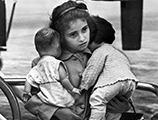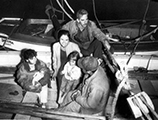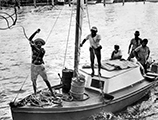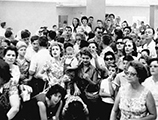The Cuban Experience in Florida: Revolution and Exodus
Lesson Plans
Lesson Plan for Grades 9-12

This lesson has been reviewed and approved by CPALMS.
Overview
Since 1959, over one million refugees have fled Cuba for the United States, particularly South Florida. These photographs were taken in 1961 and 1962 during the early stages of the Cuban exodus to the United States following the Revolution of 1959. By October 1962, nearly 250,000 Cubans had left the island for the United States. Cubans arrived in the United States with little more than the clothes on their backs. Many sought assistance from the Cuban Refugee Assistance Program (CRA). Authorized by President John F. Kennedy in 1961, the CRA provided short-term assistance in order to help Cuban refugees obtain food, shelter, and clothes. Longer-term assistance from the CRA was available for health, employment and educational training.
In this lesson, students will analyze photographs in order to write about the Cuban refugee experience. Students will strengthen their skills in analyzing primary sources and learn how events in Florida history relate to United States history.
Objectives
Students will:
- Analyze primary source documents (photographs).
- Write about history using primary sources.
- Learn about the Cuban refugee experience.
- Understand 1960s Cuban immigration in the context of the Cold War, Florida history, and United States history.
Grades
9-12
Next Generation Sunshine State Standards
-
SS.912.A.6.15: Examine key events and peoples in Florida history as they relate to United States history.
Examples are Mosquito Fleet, “Double V Campaign,” construction of military bases and WWII training centers, 1959 Cuban coup and its impact on Florida, development of the space program and NASA.
Florida Standards
- LAFS.910.RH.1.2: Determine the central ideas or information of a primary or secondary source; provide an accurate summary of how key events or ideas develop over the course of the text.
- LAFS.1112.RH.1.2: Determine the central ideas or information of a primary or secondary source; provide an accurate summary that makes clear the relationships among the key details and ideas.
Materials Needed
- Photo Analysis Worksheet from the National Archives and Records Administration
- Four photographs from the State Archives of Florida (See below.)
Photographs Set 1: Revolution and Exodus, 1961
Procedure
Part I: Introducing Content
-
Teachers should review previously covered material dealing with immigration in United States history in order to prepare students to think about Cuban immigration in the 1960s.
- What are the major periods of immigration in United States history?
- What themes or experiences are common to all immigrants?
- What might account for differences in the experience of immigrants from different countries or during different time periods?
-
Conduct an in-class discussion/survey of students’ prior knowledge of Cuban immigration and the Cold War.
- How many are Cuban or know Cubans/Cuban-Americans?
- What brought Cubans to Florida?
- What was the experience of Cuban refugees like?
- What was the relationship between Cuban immigration and the Cold War?
- Discuss some of the historical connections between Cuba and Florida (see “A Brief History” included with this unit). Explain to students that Cuban immigration to Florida occurred in the context of the Cold War and that they will learn about the experiences of ordinary people during an international crisis. Teachers should explain that Cuban immigration serves as an example that connects Florida history with major events in United States history, in this case immigration, the Cold War, and U.S.-Cuban foreign relations.
Part II: Photo Analysis
- Teachers should prompt students to think about the range of necessities in their daily lives, and then ask students to imagine that they must leave immediately for a foreign county with nothing but what they can carry. Teachers can break students into small groups and have them make a list of necessities they would need upon entering a foreign country.
- Students will analyze the four photographs included above. Teachers should alert students to look for what the refugees carried with them to the United States and compare this with the list of necessities developed by their group. Students should record their reactions to the photographs using the Primary Source Analyzing Tool, paying special attention to what they can learn from the images about the refugee experience.
Part III: Writing About the Refugee Experience
Students should write brief journal responses to the photographs focused on what they can learn from the images about the Cuban refugee experience, particularly what the refugees carried with them to the United States.

 Listen: The Latin Program
Listen: The Latin Program



